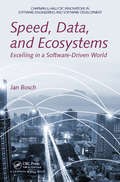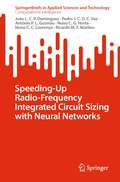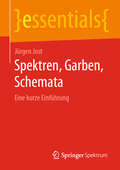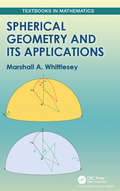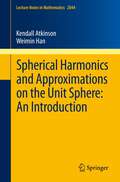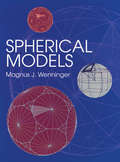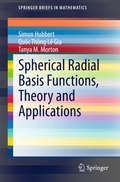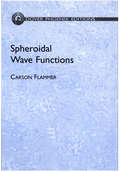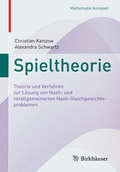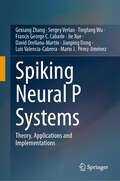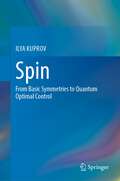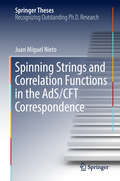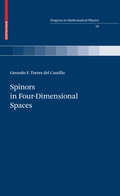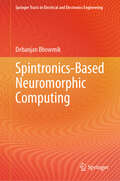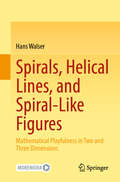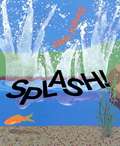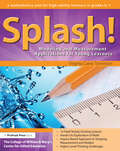- Table View
- List View
Speed, Data, and Ecosystems: Excelling in a Software-Driven World (Chapman & Hall/CRC Innovations in Software Engineering and Software Development Series)
by Jan BoschAs software R&D investment increases, the benefits from short feedback cycles using technologies such as continuous deployment, experimentation-based development, and multidisciplinary teams require a fundamentally different strategy and process. This book will cover the three overall challenges that companies are grappling with: speed, data and ecosystems. Speed deals with shortening the cycle time in R&D. Data deals with increasing the use of and benefit from the massive amounts of data that companies collect. Ecosystems address the transition of companies from being internally focused to being ecosystem oriented by analyzing what the company is uniquely good at and where it adds value.
Speeding-Up Radio-Frequency Integrated Circuit Sizing with Neural Networks (SpringerBriefs in Applied Sciences and Technology)
by Nuno C. Lourenço Ricardo M. Martins Nuno C. Horta João L. Domingues Pedro J. Vaz António P. GusmãoIn this book, innovative research using artificial neural networks (ANNs) is conducted to automate the sizing task of RF IC design, which is used in two different steps of the automatic design process. The advances in telecommunications, such as the 5th generation broadband or 5G for short, open doors to advances in areas such as health care, education, resource management, transportation, agriculture and many other areas. Consequently, there is high pressure in today’s market for significant communication rates, extensive bandwidths and ultralow-power consumption. This is where radiofrequency (RF) integrated circuits (ICs) come in hand, playing a crucial role. This demand stresses out the problem which resides in the remarkable difficulty of RF IC design in deep nanometric integration technologies due to their high complexity and stringent performances. Given the economic pressure for high quality yet cheap electronics and challenging time-to-market constraints, there is an urgent need for electronic design automation (EDA) tools to increase the RF designers’ productivity and improve the quality of resulting ICs. In the last years, the automatic sizing of RF IC blocks in deep nanometer technologies has moved toward process, voltage and temperature (PVT)-inclusive optimizations to ensure their robustness. Each sizing solution is exhaustively simulated in a set of PVT corners, thus pushing modern workstations’ capabilities to their limits. Standard ANNs applications usually exploit the model’s capability of describing a complex, harder to describe, relation between input and target data. For that purpose, ANNs are a mechanism to bypass the process of describing the complex underlying relations between data by feeding it a significant number of previously acquired input/output data pairs that the model attempts to copy. Here, and firstly, the ANNs disrupt from the most recent trials of replacing the simulator in the simulation-based sizing with a machine/deep learning model, by proposing two different ANNs, the first classifies the convergence of the circuit for nominal and PVT corners, and the second predicts the oscillating frequencies for each case. The convergence classifier (CCANN) and frequency guess predictor (FGPANN) are seamlessly integrated into the simulation-based sizing loop, accelerating the overall optimization process. Secondly, a PVT regressor that inputs the circuit’s sizing and the nominal performances to estimate the PVT corner performances via multiple parallel artificial neural networks is proposed. Two control phases prevent the optimization process from being misled by inaccurate performance estimates. As such, this book details the optimal description of the input/output data relation that should be fulfilled. The developed description is mainly reflected in two of the system’s characteristics, the shape of the input data and its incorporation in the sizing optimization loop. An optimal description of these components should be such that the model should produce output data that fulfills the desired relation for the given training data once fully trained. Additionally, the model should be capable of efficiently generalizing the acquired knowledge in newer examples, i.e., never-seen input circuit topologies.
Spektren, Garben, Schemata: Eine kurze Einführung (essentials)
by Jürgen JostDas essential führt in die wesentlichen Konzepte der modernen algebraischen Geometrie ein. Dabei werden zunächst algebraische Grundbegriffe wiederholt. Die algebraische Struktur eines kommutativen Ringes spiegelt sich in der Menge seiner Primideale wider. Diese Menge kann mit einer topologischen Struktur versehen werden; dies ist der Begriff des Spektrums, der also algebraische in topologische Daten übersetzt. Mithilfe des Begriffs der Garbe kann man aus dieser topologischen die algebraische Struktur zurückgewinnen. Dieses reichhaltige Wechselspiel wird im Begriff des Schemas erfasst. Dadurch kann man die grundlegenden Objekte der algebraischen Geometrie, Nullstellengebilde von Polynomen, algebraisch untersuchen und umgekehrt geometrische Methoden auf arithmetische Fragen anwenden.
Spend It! (A Moneybunny Book)
by Cinders McLeodA charming introduction to simple money concepts in which a bunny learns he can't buy everything he wants with his allowance!Sonny gets three whole carrots a week for his allowance and wants to buy everything with it! But he soon discovers his money won't go that far, and his mom tells him he needs to make some choices. That doesn't sound like much fun to Sonny, especially when he learns that the bouncy castle he's been eyeing goes for ONE HUNDRED carrots. Ridiculous! But eventually, after a little math and a little more thinking, he has a blast discovering what's really important to him and worth spending his carrots on.
Spending Money: Budgets, Credit Cards, Scams... And Much More! (A True Book (Relaunch))
by Jessica CohnA series to build strong financial habits early on in life!Understanding how to make a budget, how credit cards work, and how to avoid scams are just three critical financial literacy skills that all kids should have. Did you know that the first credit card was introduced in 1950? Or that American consumers lost more than $5 billion to frauds in 2021? Learn all this and more in Spending Money - a book that gives kids the confidence and know-how they need to manage their finances.ABOUT THE SERIES: How can I make money? What is inflation? What is the difference between a debit card and a credit card? Economics - and more specifically, money - play such a large role in our lives. Yet there are many mysteries and misconceptions surrounding the basic concepts of finance and smart money management. This set of True Books offers students the know-how they'll need to start on the road to financial literacy - a crucial skill for today's world. Interesting information is presented in a fun, friendly way - and in the simplest terms possible - which will enable students to build strong financial habits early on in life.
Spezielle Funktionen der Physik mit MATLAB
by Wolfgang SchweizerDieses Lehrbuch konzentriert sich auf spezielle Funktionen der Physik im reellen und komplexen Bereich. Es behandelt mehr als 170 verschiedene Funktionen mit zusätzlichen numerischen Hinweisen für effiziente Berechnungen, die für jeden nützlich sind, der auch mit anderen Programmiersprachen programmieren muss. Das Buch enthält MATLAB-basierte Programme für jede dieser Funktionen und eine ausführliche html-basierte Dokumentation. Einige der erklärten Funktionen sind: Gamma- und Beta-Funktionen; Legendre-Funktionen, die mit der Quantenmechanik und der Elektrodynamik in Verbindung stehen; Bessel-Funktionen; hypergeometrische Funktionen, die in der mathematischen Physik eine wichtige Rolle spielen; orthogonale Polynome, die vor allem in der computergestützten Physik verwendet werden; und Riemann-Zeta-Funktionen, die z. B. in der Quantenchaos- oder Stringtheorie eine wichtige Rolle spielen. Das Buch richtet sich in erster Linie an Wissenschaftler, Fachleute in Forschungsbereichen der Industrie und fortgeschrittene Studierende der Physik, der angewandten Mathematik und der Ingenieurwissenschaften.
Spezielle Relativitätstheorie: Eine Einführung mithilfe des k-Kalküls (essentials)
by Jürgen KremerDas Buch bietet eine Einführung in die Spezielle Relativitätstheorie mithilfe des k- Kalküls. Dieser Zugang ist sehr elegant und verwendet die auf der Radarmethode basierende geometrische Darstellung der zweidimensionalen Raumzeit aus der Perspektive inertialer Beobachter. Die letzten Kapitel des Buchs behandeln die vierdimensionalen Lorentz-Transformationen und die Äquivalenz von Masse und Energie. Das Buch endet mit einer Darstellung des Zusammenhangs zwischen der Signalübertragung mit Überlichtgeschwindigkeit und der Verletzung des Kausalitätsprinzips.
Spezielle und allgemeine Relativitätstheorie für Bachelorstudenten
by Reinhard MeinelDieses Lehrbuch bietet bereits im Bachelorstudium einen gut verständlichen Zugang nicht nur zur speziellen, sondern auch zur allgemeinen Relativitätstheorie. Besonderheiten: Erstmals in einem Lehrbuch wird eine physikalische Herleitung der berühmten Kerr-Newman-Lösung gegeben. Dank der zahlreichen Übungsaufgaben mit ausführlich dargestellten Lösungen ist das Buch auch zum Selbststudium geeignet. Inhalt: Einführung – Der Minkowski-Raum, die Raumzeit der SRT – Lorentz-Transformationen – Vierervektoren und Vierertensoren – Relativistische Punktmechanik – Andere Teilgebiete der Physik im Rahmen der SRT – Grundideen der ART – Geometrie der Raumzeit – Physik in der gekrümmten Raumzeit – Die Einstein'schen Feldgleichungen – Der Newton'sche Grenzfall – Die Schwarzschild-Lösung – Die klassischen Effekte der ART – Kugelsymmetrische Sternmodelle – Die Schwarzschild-Lösung als Schwarzes Loch – Das Wirkungsprinzip der ART – Ausblick auf Gravitationswellen, Kosmologie und Quantengravitation – Mathematische Methoden – Rotierende und elektrisch geladene Schwarze Löcher – Die rotierende Staubscheibe Neuerungen (3. Aufl.): Neben neuen Aufgaben und Lösungen wurde auch ein Abschnitt zur Thermodynamik Schwarzer Löcher hinzugefügt. Zielgruppe: Studierende und Lehrende der Physik, sowohl im Hauptstudium als auch im Lehramtsstudium Vorkenntnisse: Vorausgesetzt werden lediglich Grundkenntnisse der klassischen Mechanik und der Elektrodynamik sowie der zugehörigen mathematischen Hilfsmittel.
Spezielle und allgemeine Relativitätstheorie: Grundlagen, Anwendungen in Astrophysik und Kosmologie sowie relativistische Visualisierung
by Thomas Müller Sebastian Boblest Günter WunnerDieses Lehrbuch verknüpft die mathematischen Grundlagen der speziellen und allgemeinen Relativitätstheorie mit zahlreichen Anwendungsgebieten aus Physik und Astronomie. Neben der Diskussion von klassischen Experimenten, welche die Vorhersagen der Relativitätstheorie bestätigen, wird ein Fokus auf die Kosmologie als Anwendung der Relativitätstheorie gesetzt. Die Behandlung der Physik kompakter stellarer Objekte, d. h. von weißen Zwergen, Neutronensternen und Schwarzen Löchern, mit einem kurzen Abschnitt zur Entstehung und Entwicklung von Sternen runden die Darstellung ab.Einen besonderen Schwerpunkt legen die Autoren auf die relativistische Visualisierung. In zwei Kapiteln bekommt der Leser einen Überblick über verschiedene Techniken in der speziellen und allgemeinen Relativitätstheorie. Anhand von Beispielen können die der Alltagserfahrung scheinbar widersprechenden Vorhersagen der Relativitätstheorie besser fassbar gemacht werden. Die daraus gewonnenen Abbildungen und begleitenden Videos, die über die SN More Media App zugänglich sind, erweitern das Verständnis der im Text behandelten Themen.In der vorliegenden zweiten Auflage haben die Autoren vor allem neuere Entwicklungen (z.B. zum Thema Gravitationswellen) aufgenommen und zudem viele kleinere Verbesserungen und Ergänzungen vorgenommen. Das Buch richtet sich besonders an Studierende der Physik und verwandter Studiengänge, die sich einen Überblick über die Relativitätstheorie und ihre Anwendungsgebiete verschaffen möchten, aber auch interessierte Laien können damit interessante Einsichten gewinnen.
Spherical Geometry and Its Applications (Textbooks in Mathematics)
by Marshall A. WhittleseySpherical Geometry and Its Applications introduces spherical geometry and its practical applications in a mathematically rigorous form. The text can serve as a course in spherical geometry for mathematics majors. Readers from various academic backgrounds can comprehend various approaches to the subject. The book introduces an axiomatic system for spherical geometry and uses it to prove the main theorems of the subject. It also provides an alternate approach using quaternions. The author illustrates how a traditional axiomatic system for plane geometry can be modified to produce a different geometric world – but a geometric world that is no less real than the geometric world of the plane. Features: A well-rounded introduction to spherical geometry Provides several proofs of some theorems to appeal to larger audiences Presents principal applications: the study of the surface of the earth, the study of stars and planets in the sky, the study of three- and four-dimensional polyhedra, mappings of the sphere, and crystallography Many problems are based on propositions from the ancient text Sphaerica of Menelaus
Spherical Harmonics and Approximations on the Unit Sphere: An Introduction
by Kendall Atkinson Weimin HanThese notes provide an introduction to the theory of spherical harmonics in an arbitrary dimension as well as an overview of classical and recent results on some aspects of the approximation of functions by spherical polynomials and numerical integration over the unit sphere. The notes are intended for graduate students in the mathematical sciences and researchers who are interested in solving problems involving partial differential and integral equations on the unit sphere, especially on the unit sphere in three-dimensional Euclidean space. Some related work for approximation on the unit disk in the plane is also briefly discussed, with results being generalizable to the unit ball in more dimensions.
Spherical Models
by Magnus J. WenningerWell-illustrated, practical approach to creating star-faced spherical forms that can serve as basic structures for geodesic domes. Complete instructions for making models from circular bands of paper with just a ruler and compass. Discusses tessellation, or tiling, and how to make spherical models of the semiregular solids and concludes with a discussion of the relationship of polyhedra to geodesic domes and directions for building models of domes. ". . . very pleasant reading." -- Science. 1979 edition.
Spherical Radial Basis Functions, Theory and Applications
by Simon Hubbert Quôc Thông Lê Gia Tanya M. MortonThis book is the first to be devoted to the theory and applications of spherical (radial) basis functions (SBFs), which is rapidly emerging as one of the most promising techniques for solving problems where approximations are needed on the surface of a sphere. The aim of the book is to provide enough theoretical and practical details for the reader to be able to implement the SBF methods to solve real world problems. The authors stress the close connection between the theory of SBFs and that of the more well-known family of radial basis functions (RBFs), which are well-established tools for solving approximation theory problems on more general domains. The unique solvability of the SBF interpolation method for data fitting problems is established and an in-depth investigation of its accuracy is provided. Two chapters are devoted to partial differential equations (PDEs). One deals with the practical implementation of an SBF-based solution to an elliptic PDE and another which describes an SBF approach for solving a parabolic time-dependent PDE, complete with error analysis. The theory developed is illuminated with numerical experiments throughout. Spherical Radial Basis Functions, Theory and Applications will be of interest to graduate students and researchers in mathematics and related fields such as the geophysical sciences and statistics.
Spheroidal Wave Functions
by Carson FlammerIntended to facilitate the use and calculation of spheroidal wave functions, this applications-oriented text features a detailed and unified account of the properties of these functions. Addressed to applied mathematicians, mathematical physicists, and mathematical engineers, it presents tables that provide a convenient means for handling wave problems in spheroidal coordinates.Topics include separation of the scalar wave equation in spheroidal coordinates, angle and radial functions, integral representations and relations, and expansions in spherical Bessel function products. Additional subjects include recurrence relations of Whittaker type, asymptotic expansions for large values of c, and vector wave functions. The text concludes with an appendix, references, and tables of numerical values.
Spiel, Zufall und Kommerz: Theorie und Praxis des Spiels um Geld zwischen Mathematik, Recht und Realität
by Thomas BronderDas Spiel mit dem Glück Von Brett- und Kartenspielen über Glücksspielautomaten bis hin zu Lotterien und Wettbüros – dieses Buch ist ebenso breit angelegt wie die Welt des Spiels und zeigt, was all diesen Spielen gemeinsam ist und wie sie wirklich funktionieren. Dabei geht um den Vergleich diverser Spielsysteme anhand wertneutraler Merkmale insbesondere zum Unterschied von Glücks- und Geschicklichkeitsspielen. Wo regieren der Zufall und der Kommerz, wo die Geschicklichkeit? Wie greifen sie ineinander, und welchen rechtlichen Regelungen unterliegt das kommerzielle Spiel? Was macht den besonderen Reiz der Pokerspiele aus? Viele Beispiele zeichnen historische Entwicklungen nach, Zusammenhänge und Gesetze der Wahrscheinlichkeitstheorie werden anschaulich erklärt und lange Spielfolgen bis zum „Point of no return“ bildlich dargestellt. Thomas Bronder räumt außerdem mit vielen Irrtümern, ungenauen Begriffsvorstellungen und Missverständnissen auf, etwa zu Chancengleichheit, Verlusttempo und Auszahlquoten. Vom erfolgreichen Buchmachen über erfolglose Gewinnsysteme bis zu Schneeballsystemen, Falschspiel, Betrug und Manipulation wird kein Thema ausgelassen. So liegt hiermit nun eine kleine „Bibel“ des Spiels um Geld vor, die nicht nur für Spieler, Journalisten und Juristen interessant ist.Die zweite Auflage enthält viele Ergänzungen und Korrekturen mit einem umfangreichen Sachwortverzeichnis zum Nachschlagen. Sie teilt Nullsummenspiele in fünf Klassen ein, beschreibt Besonderheiten beim Pokern und geht auf die Probleme mit Online-Glücksspielen im Internet ein.
Spieltheorie: Theorie und Verfahren zur Lösung von Nash- und verallgemeinerten Nash-Gleichgewichtsproblemen (Mathematik Kompakt)
by Christian Kanzow Alexandra SchwartzDas Buch gibt eine Einführung in einige zentrale Konzepte der (mathematischen) Spieltheorie und legt seinen Fokus dabei auf die Lösung von Nash- und verallgemeinerten Nash-Gleichgewichtsproblemen. Die meisten Probleme der Spieltheorie lassen sich nicht von Hand lösen; stattdessen ist man auf geeignete numerische Verfahren angewiesen, mit deren Hilfe zumindest eine Näherungslösung berechnet werden kann. Einen Schwerpunkt dieses Buches bilden daher eine ganze Reihe von Methoden meist neueren Datums, die hier erstmals in Buchform präsentiert werden und zur numerischen Lösung von Nash- und verallgemeinerten Nash-Gleichgewichtsproblemen verwendet werden können. Aber auch Existenz- und Eindeutigkeitssätze sowie Zwei-Personen-Spiele werden ausführlich diskutiert. Darüber hinaus werden in eigenen Abschnitten die benötigten mathematischen Grundlagen zur Verfügung gestellt. Dazu gehören Aussagen über konvexe und monotone Funktionen sowie Optimalitätsbedingungen aus der restringierten Optimierung.
Spiking Neural P Systems: Theory, Applications and Implementations
by Tingfang Wu Gexiang Zhang Sergey Verlan Mario J. Pérez-Jiménez Jie Xue Francis George Cabarle David Orellana-Martín Jianping Dong Luis Valencia-CabreraSpiking neural P systems represent a significant advancement in the field of membrane computing, drawing inspiration from the communication patterns observed in neurons. Since their inception in 2006, these distributed and parallel neural-like computing models have gained popularity and emerged as important tools within the membrane computing area. As a key branch of the third generation of artificial neural networks, a fascinating research area of artificial intelligence, spiking neural P systems offer a captivating blend of theoretical elegance and practical utility. Their efficiency, Turing completeness, and real-life application characteristics, including interpretability and suitability for large-scale problems, have positioned them at the forefront of contemporary research in membrane computing and artificial intelligence. This state-of-the-art reference work is organized into three parts comprising twelve chapters. It thoroughly investigates the theoretical foundations, real-life applications, and implementations of spiking neural P systems. From fundamental principles to computational power and complexity, the theoretical aspects are explored, laying the groundwork for understanding their practical applications. Real-life applications span a diverse range of domains, including complex optimization, classification, fault diagnosis, medical image processing, information fusion, cryptography, and robot control. Additionally, the book discusses several software and hardware implementations that provide valuable insights into the practical deployment of spiking neural P systems. As the rapid development of spiking neural P systems continues to unfold, there is an increasing demand for a systematic and comprehensive summary of their capabilities and applications. This work serves as an invaluable resource for researchers, scholars, and practitioners interested in the theoretical underpinnings, algorithms, and practical implementation of artificial intelligence and membrane computing.
Spillovers to Emerging Equity Markets: An Econometric Assessment
by Tao Sun L. Effie PsalidaA report from the International Monetary Fund.
Spin: From Basic Symmetries to Quantum Optimal Control
by ILYA KUPROVThis monograph is a fundamental reference for scientists and engineers who encounter spin processes in their work. The author, Ilya Kuprov, derives the concept of spin from basic symmetries and gives an overview of theoretical and computational aspects of spin dynamics: from Dirac equation and spin Hamiltonian, through coherent evolution and relaxation theories, to quantum optimal control, and all the way to practical implementation advice for parallel computers.
Spinning Strings and Correlation Functions in the AdS/CFT Correspondence (Springer Theses)
by Juan Miguel NietoThis book addresses several aspects of the integrable structure of the AdS/CFT correspondence. In particular it presents computations made on both sides of the AdS/CFT correspondence, at weak and at strong coupling. On the string theory side of the correspondence, the book focuses on the evaluation of the energy spectrum of closed string solutions moving in some deformed backgrounds that preserve integrability. On the gauge theory side, it explores various formal problems arising in the computation of two and three-point functions by means of the Algebraic Bethe Ansatz and the Quantum Inverse Scattering method. The book features numerous results on integrability in the context of the AdS/CFT correspondence. Self-contained and pedagogical, it includes general discussions and detailed presentations on the use of integrable systems techniques and their applications.
Spinors in Four-Dimensional Spaces
by Gerardo F. Torres del CastilloWithout using the customary Clifford algebras frequently studied in connection with the representations of orthogonal groups, this book gives an elementary introduction to the two-component spinor formalism for four-dimensional spaces with any signature. Some of the useful applications of four-dimensional spinors, such as Yang-Mills theory, are derived in detail using illustrative examples. Spinors in Four-Dimensional Spaces is aimed at graduate students and researchers in mathematical and theoretical physics interested in the applications of the two-component spinor formalism in any four-dimensional vector space or Riemannian manifold with a definite or indefinite metric tensor. This systematic and self-contained book is suitable as a seminar text, a reference book, and a self-study guide.
Spintronics-Based Neuromorphic Computing (Springer Tracts in Electrical and Electronics Engineering)
by Debanjan BhowmikThe book discusses almost all aspects of spintronics-based neuromorphic computing, starting from a very basic level, and will be of interest to both spintronics and neuromorphic computing communities. The chapters also cover most simulation and experimental studies reported recently by researchers worldwide on this topic. The book includes an introductory chapter on nanomagnetism and spin physics and another on neural network algorithms (covering both the machine-learning and neuroscience aspects of these algorithms). These introductory chapters will help the readers build their background and truly appreciate the recent research results on spintronics-based neuromorphic computing, presented in the later chapters of the book. Various numerical simulation exercises are also provided in the book.
Spirals, Helical Lines, and Spiral-Like Figures: Mathematical Playfulness in Two and Three Dimensions
by Hans WalserIn this book you will discover the mathematical patterns and regularities of various spirals, helixes and spiral-like figures. Their geometric aspects and connections are presented in a visually appealing way and are supplemented as best as possible with analytical aspects and representations. Using examples from technology and nature, you will learn about round, square, golden and spherical spirals and examine their curvature behavior and other exciting properties. The examples are arranged thematically and the book has a modular structure so that the individual chapters can be read largely independently of each other. It is therefore a valuable resource for students, pupils, (prospective) teachers, those interested in mathematics and those who want to become one.Additional animations are available with the SN More Media app: simply download the SN More Media app free of charge, scan an image or a link with the play button and immediately play the animation on your smartphone or tablet.The translation was done with the help of artificial intelligence. A subsequent human revision was done primarily in terms of content.
Splash!
by Ann JonasIt's hard to keep up with the goings-on at Ann Jonas's pond. What fun young readers will have keeping track! Cat. Dog. Frog. Fish. Who went in and who jumped out? Here is a counting book as fresh as a spring-fed pond.
Splash!: Modeling and Measurement Applications for Young Learners in Grades K-1
by Clg Of William And Mary/Ctr Gift Ed Virginia Caine TonnesonSplash! is a mathematics unit for high-ability learners in kindergarten and first grade focusing on concepts related to linear measurement, the creativity elements of fluency and flexibility, and the overarching, interdisciplinary concept of models. The unit consists of 13 lessons centered on the idea of designing a community pool. Students examine the question of why we measure, the importance of accuracy in measurement, and the various units and tools of measurement. The unit presents a hands-on, constructivist approach, allowing children to build their knowledge base and their skills as they explore mathematical ideas through play and planned investigations. Students are involved in creative and critical thinking, problem solving, process skill development, and communication.Grades K-1
